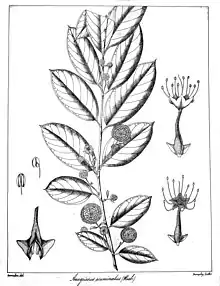| Terminalia phillyreifolia | |
|---|---|
 | |
| Botanical illustration | |
| Scientific classification | |
| Kingdom: | Plantae |
| Clade: | Tracheophytes |
| Clade: | Angiosperms |
| Clade: | Eudicots |
| Clade: | Rosids |
| Order: | Myrtales |
| Family: | Combretaceae |
| Genus: | Terminalia |
| Species: | T. phillyreifolia |
| Binomial name | |
| Terminalia phillyreifolia (Van Heurck & Müll.Arg.) Gere & Boatwr. | |
| Synonyms[1] | |
|
List
| |
Terminalia phillyreifolia is an Asian species of tree in the family Combretaceae. It has been called buttontree[3] or yon[4] (from Burmese: ရုံး; MLCTS: rum:; IPA: [jṍʷ]). It is a medium-sized tree found in both primary and secondary tropical and sub-tropical forests. It is recorded from India to China, south to Thailand and Vietnam.[1] It may be one of the dominant species of deciduous forests of Vietnam.[5] In Yunnan it is found in rocky limestone areas, near sea level to 700 m (2,300 ft).[6]
Besides timber uses, the bark of this species has a high tannin content.
Taxonomy
Formerly known as Anogeissus acuminata, a 2017 article embedded genera including Anogeissus into Terminalia.[7] Several varieties were accepted in the 2017 Catalogue of Life checklist;[8] no varieties are listed in Kew's Plants of the World Online as of April 2021.[1]
Description
In China, where it is known as 榆绿木 (yu lü mu), these trees grow to 20 m (66 ft) tall with a trunk to 1 m (3 ft 3 in) in diameter at breast height.[6] In Myanmar they may be larger: up to 30 m (98 ft) tall and up to 2.7 m (8 ft 10 in) girth, with a straight and cylindrical trunk.[9] The branchlets are slightly pendent, slender, together with petioles and leaf blades golden villous when young. The petioles are cylindrical, 2–6 mm and the leaf blades are lanceolate to narrowly so, 40-80 × 10–30 mm long, grey-green on the back and pilose mostly in the axils of lateral veins. They are green and glabrous to glabrescent on the leaf surface. The leaf base is narrowed or obtuse, the apex acuminate. There are five to seven inconspicuous lateral veins in pairs.[6]
The flowers are numerous sessile on flower heads 9–13 mm in diameter; bracts are easily deciduous and linear, 4–5 mm long. The calyx tubes are approximately 5 mm long, abaxially yellow pubescent, densely so on ovary and tubular part, and more sparsely so on the cup-shaped part. The filaments are 3–4 mm long. The fruits are approximately 6 × 5 mm long including a "beak". They are ferruginous pubescent distally and on the beak.
Terminalia phillyreifolia flowers between February and March in Bangladesh and Thailand.
References
- 1 2 3 "Terminalia phillyreifolia (Van Heurck & Müll.Arg.) Gere & Boatwr". Plants of the World Online. Royal Botanic Gardens, Kew. Retrieved 18 April 2021.
- ↑ Guillemin JBA, Perrottet GS, Leprieur FMR, Richard A (1832) Florae Senegambiae tentamen. Tomus primus: seu Historia plantarum in diversis Senegambiae regionibus a peregrinatoribus Perrottet et Leprieur detectarum 1: 280.
- ↑ Quattrocchi, Umberto (2012). CRC World Dictionary of Medicinal and Poisonous Plants: Common Names, Scientific Names, Eponyms, Synonyms, and Etymology. Boca Raton and London and New York: CRC Press. p. 314. ISBN 978-1-4822-5064-0.
- ↑ Trotter, H. (1941). The common commercial timbers of India and their uses. Delhi: Manager of Publications. p. 45.
- ↑ Blanc L, Maury-Lechon G, Pascal J-P (2000) Structure, floristic composition and natural regeneration in the forests of Cat Tien National Park, Vietnam: an analysis of the successional trends. Journal of Biogeography, 27: 141–157.
- 1 2 3 Flora of China 13: 314. 2007
- ↑ Maurin, Olivier; Gere, Jephris; van Der Bank, Michelle; Boatwright, James Stephen (2017). "The inclusion of Anogeissus, Buchenavia and Pteleopsis in Terminalia (Combretaceae: Terminaliinae)". Botanical Journal of the Linnean Society. 184 (3): 312–325. doi:10.1093/botlinnean/box029.
- ↑ Roskov Y.; Kunze T.; Orrell T.; Abucay L.; Paglinawan L.; Culham A.; Bailly N.; Kirk P.; Bourgoin T.; Baillargeon G.; Decock W.; De Wever A. (2014). Didžiulis V. (ed.). "Species 2000 & ITIS Catalogue of Life: 2014 Annual Checklist". Species 2000: Reading, UK. Retrieved 24 September 2018.
- ↑ ITTO Tropical Forest News (accessed 27/12/2016)